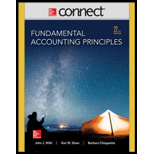
Concept explainers
Compound Interest is the interest which is calculated on the initial principal amount as well as on the interest that is accumulated. Compound interest can be compounded annually, compounded semi annually, compounded quarterly, monthly, daily etc.
To Determine:-
Here, in the problem provided to us, we are required to ascertain the initial amount that Otto co. can borrow if there are four payments of $13, 000 each and the interest rate is 8% or 12% or 16% compounded semi annually.
Answer to Problem 11E
Solution:-
When the compounding is done semi annually the interest rate is divided by two, since there are two periods in the year when the interest would be charged.
In the given problem, we have been asked to provide the amount which Otto co. can borrow at various interest rates compounded semi annually.
When the interest rate is 8% compounded semi annually, the Otto can borrow $47189.
When the interest rate is 12% compounded semi annually, the Otto can borrow $45046.
When the interest rate is 16% compounded semi annually, the Otto can borrow $43058.
Explanation of Solution
Explanation:-
Following formula has been used:
, Where n is the number of periods compounded.
Now, when the interest rate is 8% compounded semi annually, then the amount that Otto co. can borrow is as follows:-
It can be proved with an amortisation table:-
| Date | Opening balance | Interest Amount @4% | Principal Amount | Closing Balance |
| 01-11-2015 | 47189 | 1887.56 | 11112.44 | 36076.56 |
| 01-05-2016 | 36077 | 1443 | 11557 | 24520 |
| 01-11-2016 | 24520 | 981 | 12019 | 12500 |
| 01-05-2017 | 12500 | 500 | 12500 | 0 |
Now, when the interest rate is 12% compounded semi annually, then the amount that Otto co. can borrow is as follows:-
It can be proved with an amortisation table:-
| Date | Opening balance | Interest Amount @6% | Principal Amount | Closing Balance |
| 01-11-2015 | 45046 | 2702.76 | 10297.24 | 34748.76 |
| 01-05-2016 | 34749 | 2085 | 10915 | 23834 |
| 01-11-2016 | 23834 | 1430 | 11570 | 12264 |
| 01-05-2017 | 12264 | 736 | 12264 | 0 |
Now, when the interest rate is 16% compounded semi annually, then the amount that Otto co. can borrow is as follows:-
It can be proved with an amortisation table:-
| Date | Opening balance | Interest Amount @8% | Principal Amount | Closing Balance |
| 01-11-2015 | 43058 | 3444.64 | 9555.36 | 33502.64 |
| 01-05-2016 | 33503 | 2680 | 10320 | 23183 |
| 01-11-2016 | 23183 | 1855 | 11145 | 12037 |
| 01-05-2017 | 12037 | 963.0 | 12037 | 0 |
Conclusion:-
As can be seen that with the increase in interest rate the amount that Otto co. can borrow is decreasing, since it has to pay more interest on the same amount.
Want to see more full solutions like this?
- Please provide the accurate answer to this financial accounting problem using appropriate methods.arrow_forwardI am searching for the accurate solution to this general accounting problem with the right approach.arrow_forwardCan you help me solve this general accounting question using the correct accounting procedures?arrow_forward
- Can you help me solve this general accounting question using the correct accounting procedures?arrow_forwardI need help solving this general accounting question with the proper methodology.arrow_forwardI need the correct answer to this general accounting problem using the standard accounting approach.arrow_forward

 AccountingAccountingISBN:9781337272094Author:WARREN, Carl S., Reeve, James M., Duchac, Jonathan E.Publisher:Cengage Learning,
AccountingAccountingISBN:9781337272094Author:WARREN, Carl S., Reeve, James M., Duchac, Jonathan E.Publisher:Cengage Learning, Accounting Information SystemsAccountingISBN:9781337619202Author:Hall, James A.Publisher:Cengage Learning,
Accounting Information SystemsAccountingISBN:9781337619202Author:Hall, James A.Publisher:Cengage Learning, Horngren's Cost Accounting: A Managerial Emphasis...AccountingISBN:9780134475585Author:Srikant M. Datar, Madhav V. RajanPublisher:PEARSON
Horngren's Cost Accounting: A Managerial Emphasis...AccountingISBN:9780134475585Author:Srikant M. Datar, Madhav V. RajanPublisher:PEARSON Intermediate AccountingAccountingISBN:9781259722660Author:J. David Spiceland, Mark W. Nelson, Wayne M ThomasPublisher:McGraw-Hill Education
Intermediate AccountingAccountingISBN:9781259722660Author:J. David Spiceland, Mark W. Nelson, Wayne M ThomasPublisher:McGraw-Hill Education Financial and Managerial AccountingAccountingISBN:9781259726705Author:John J Wild, Ken W. Shaw, Barbara Chiappetta Fundamental Accounting PrinciplesPublisher:McGraw-Hill Education
Financial and Managerial AccountingAccountingISBN:9781259726705Author:John J Wild, Ken W. Shaw, Barbara Chiappetta Fundamental Accounting PrinciplesPublisher:McGraw-Hill Education





